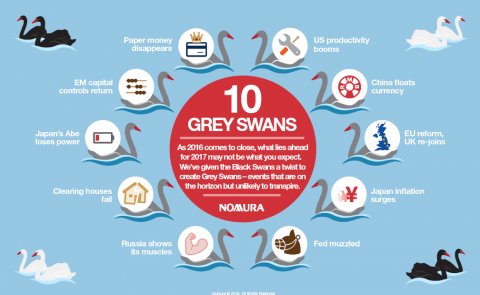Learn a new word: The Grey Swan Event
For some fun for a snowy Friday, (at least in my part of the world), let's have another installment of the often imitated but never duplicated 'Learn a new word' series, wherein I share the definition and give a couple of examples of a word, phrase, or concept I never knew before recently.
You likely have heard of the term 'Black Swan', an event or occurrence, (sometimes even a person of rare talent), that is unpredictable, (really NOT predictable), is incredibly unique, happens infrequently, and often has significant consequences. Some examples of 'Black Swans' could be a disruptive new invention, like the internet, a global conflict like World War I, or a business or economic event that could not be predicted like the financial crisis of 2007 and 2008.
Black Swans are so rare, so unpredictable, and so unique that generally speaking it is a waste of time, energy, and resources to try and predict them or forecast or plan for them.
But not all unusual or unanticipated events are true Black Swans. Some of these, at least in theory, could be foreseen or at least imagined. These kinds of events are today's Learn a new word', these are the 'Grey Swans'. The Grey Swan is an unlikely, but impactful event that generally lies outside the base case for business planning but can, if you have just a little bit of ability to think laterally, be envisaged.
The chart on the right created by Nomura Securities shows a few of these Grey Swan possibilities from the world of global economics and finance. Some seem kind of crazy, and some, maybe not so much out ot the realm of potential economic events.
When Nomura put together these possible Grey Swan events, they were purposefully seeking to identify, and more importantly try and plan for, events that are not being generally discussed, remain under the radar, but if they did occur would have significant, and potentially negative consequences for the bank's business.
The lesson for the rest of us as we wind down 2016 and think about our plans for next year?
Maybe build in a few Grey Swans of your own into your scenario planning for 2017. Maybe the CEO AND the COO might both resign in the first quarter. Maybe the new administration will dramatically reduce the availability of foreign worker visas, or maybe Amazon will decide to get into your business, and disrupt the heck out of everything you do.
Who knows? That's why these kinds of events are called Grey Swans.
Sure, they probably won't happen. But if one does, it sure will be good to be the guy or gal who saw it coming.
Have a great weekend!

 Steve
Steve
